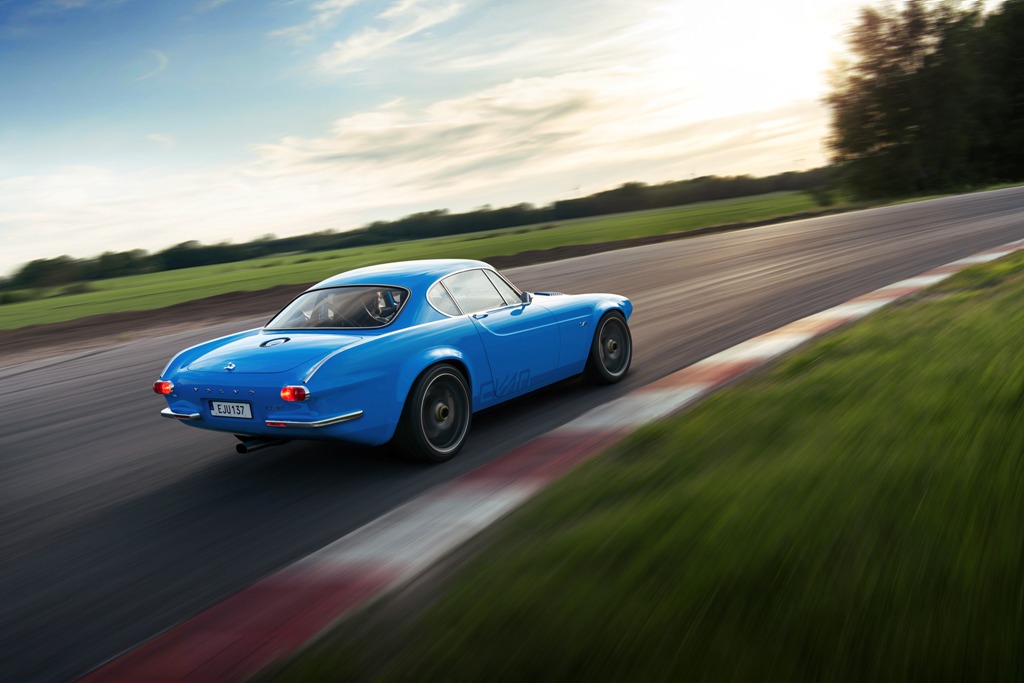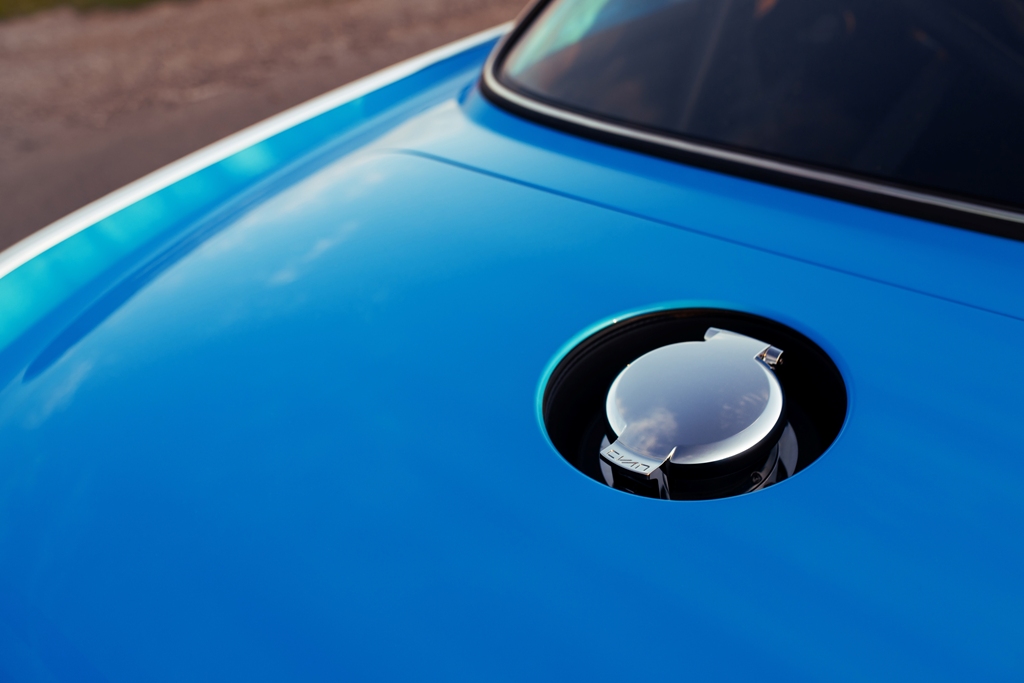Cyan Racing Reveals the Volvo P1800 Cyan
Cyan Racing, the reigning triple World Touring Car Champions, has revealed the Volvo P1800 Cyan, an interpretation of the iconic Volvo sports car from the sixties. The car is engineered by the team behind the first world title-winning Volvo race car and the Volvo C30 Polestar Concept Prototype.
Our company was founded in 1996 to race Volvo cars in Sweden, and the Volvo P1800 Cyan is closing the circle for us,” said Christian Dahl, CEO and founder of Cyan Racing.
“We claimed our first world title with Volvo in 2017 and have since then won two further world titles with two other manufacturers. The first world title was a milestone for us, and we felt it was a good time to reconnect with the past and to those before us racing Volvos. The first Volvo P1800 Cyan carries our blue and yellow racing colours to mark our heritage.”
What Could Have Been
The original Volvo P1800 was unveiled in 1960, a year before the Jaguar E-Type, two years before the Ferrari 250 GTO and three years before the Porsche 911.
“The Jaguar, the Ferrari and the Porsche are all cars with a continuation,” said Christian Dahl.
“That left us with inspiration to create what could have been if we as a race team had been there during the sixties, racing the P1800, and got to design a road version of our race car.”
“We have done that before with three of our race cars, the Volvo C30, the Volvo S60, when we were known as Polestar, and last year the Lynk & Co 03 Cyan. The Volvo P1800 Cyan is our interpretation of what could have been.”
Light-Weight Carbon Fibre and High-Strength Steel Body
The Volvo P1800 body has been altered to accommodate a wider track, larger wheels and repositioned greenhouse, among a long list of redesigns.
“To put together an interpretation of iconic design is a challenge. I think we succeeded in merging new technology without losing the character of the original Volvo P1800,” said Ola Granlund, Head of Design at Cyan Racing.
The Volvo P1800 Cyan started life as a 1964 Volvo P1800 that has been refined and reinforced utilising high-strength steel and carbon fibre.
“The basis for a precise and intuitive driving experience is a solid body structure. Cars from the sixties are far from ideal when it comes to this due to weak points and steel quality that allow for flex,” said Mattias Evensson.
“We have redesigned the structure of the original shape and strengthened weak points in the chassis through triangulation, using high-strength steel and integrated the carbon fibre body with the chassis structure.
“The carbon fibre is not just a fine shell of separate panels, but rather structural components joined with high-strength adhesive to the steel. All parts of the carbon fibre are adding to the structural rigidity.”
This process is a key part of enabling low weight and high responsiveness, with the car weighing just 990 kilos.
Engine and Transmission Design
The two-litre turbocharged four-cylinder engine is based on the same engine as used in the world title-winning Volvo S60 TC1 race car, producing 420 horsepower and 455Nm of torque, with a redline at 7700 rpm.
Although the engine is turbocharged, it is developed to deliver a linear power and torque curve with the characteristics of a normally aspirated engine. The engine character is designed to deliver a driving experience as in the sixties but with increased performance and precision.
“While evaluating engines for the Volvo P1800 Cyan, we considered a wide range of Volvo engines, including the original B18, the ‘Red Block’ B230, the 5-cylinder ‘White Block’, the short inline 6-cylinder and the 4-cylinder VEA engine that power Volvos of today,” said Mattias Evensson.
“The efficient and lightweight VEA (Volvo Engine Architecture) gave us the best base, also allowing us to transfer our experience from the different versions of the VEA that we have designed for our race and performance cars of the past decade.”
The engine made its debut in the 2011 Volvo C30 world-touring race car and was a key part in claiming the 2017 world title.
“It is an engine that provides us with a strong mechanical base and a very efficient combustion system. We have adapted it to suit the Volvo P1800 Cyan with the power output increasing through the entire powerband,” said Mattias Evensson.
“The power peaks late. It is designed for high revs a lot, with the torque intuitively linear to the pedal. We have learnt from racing where the drivers want perfect control of the torque, increasing precision and driving pleasure at the same time.”
A five-speed bespoke Holinger gearbox has been selected to carry the mechanical feeling of the original Volvo P1800 but with greater gear change precision and capability of handling the increased torque.
The original Volvo P1800 live rear axle is replaced with a Cyan-designed independent rear suspension.
A key part to the engaging rear-wheel-drive experience is the torque-biasing limited-slip differential. The differential is mounted in a Holinger housing with unique gears in order to combine capable performance on a circuit with civilised behaviour for road use.
A Pure Driver-Focused Chassis
The fully adjustable front and rear suspension feature bespoke lightweight components, including aluminium uprights, double wishbones and two-way adjustable dampers with Cyan hydraulics.
“We are really satisfied with the level of grip and precision that we have achieved from the chassis in combination with responsive steering,” said Thed Björk, development driver and 2017 touring car world champion for Cyan Racing.
“The car goes where you point it. You can be brutal going into a corner and still find your apex and exit within millimetres.
“The settings of the car are not aimed at fast lap times but rather to deliver an enjoyable and exciting driving experience. I feel my smile widening each time that I control the drift angle of the car through a long turn.”
The carbon fibre-reinforced chassis is connected to the road with 18″ forged rims with Pirelli P Zero 235/40 tyres at the front and 265/35 at the rear.
4-piston callipers control the car with 362x32mm steel discs with genuine feeling as no brake booster, or ABS is there to interfere.
World Title Engineering Team
Cyan Racing’s engineering team originates from more than two decades of developing racing cars and over a decade of developing performance road cars.
The engineering team involved competences from Cyan’s design, aero, engine, chassis and electronics departments.
“The Volvo P1800 Cyan is the result of an advanced engineering process, involving many of the same talents who designed, built and developed our world title-winning Volvo S60 TC1 Cyan,” said Christian Dahl.
The Volvo C30 Polestar Performance Prototype, the first road car of Cyan Racing, was used for benchmarking throughout the development process.
“A vital part of the project was to reconnect with our first road car,” said Mattias Evensson.
“We wanted to carry over some of the driving feeling and performance availability from that car, and it has been thoroughly useful throughout the development process.”
Pricing and individual specification are available for prospective clients.
Technical Specifications
Engine
Aspiration: Turbocharged
Size: 2000cc
Number of cylinders: 4
Cylinder alignment: Inline
Valves per cylinder: 4
Bore x stroke: 82×93.2 mm
Compression ratio: 10.2:1
Maximum HP/kW: 420 hk/308 kW @ 7000 rpm
Maximum torque: 455 Nm @ 6000 rpm
Maximum boost: 2.7 bar
Maximum RPM: 7700 rpm
Fuel system: Direct injection
Turbo: Borg Warner EFR, ceramic ball bearings, gamma-ti turbine wheel
Exhaust: Dual tube stainless steel, twin catalytic converters
Transmission
Drive wheels: RWD
Gearbox type: Manual synchromesh helical-cut dog leg
Number of gears: 5
Clutch: 200 mm, organic disc
Flywheel: Single mass steel
Prop shaft: Carbon fibre
Final drive: LSD with the customisable ratio
Dimensions
Wheelbase: 2446 mm
Length: 4203 mm
Width: 1748 mm
Height: 1220 mm
Track front: 1466 mm
Track rear: 1489 mm
Fuel tank capacity: 57 litres
Suspension and Body
Front: Double wishbone, adjustable camber, caster, toe and bump steer
Rear: Double wishbone, adjustable camber and toe
Dampers: Adjustable compression and rebound front and rear
Anti-roll bars: Tubular anti-roll bars front and rear, adjustable rear stiffness
Steering rack: Rack and pinion with adjustable ratio
High-strength steel and carbon fibre body
Roll cage made in titanium
Brakes
Front: 4-piston calliper, 362×32 mm disc
Rear: 4-piston caliper, 330×25.4 mm disc
Wheels
Front tyre size: Pirelli P Zero 235/40-R18
Rear tyre size: Pirelli P Zero 265/35-R18
Front rim size: 8.5”x18.”
Rear rim size: 9.5”x18.”
Centerlock wheels
Weight
Curb weight: 990kg
Weight distribution: F: R 47:53%
NEXT UP IN NEWS
- New Opel Mokka Combines Fun and Modernity
- ŠKODA Proactive Care Connect Services Free for 10 Years
- Ron Capps Takes Don Schumacher Racing HEMI-powered Dodge Charger SRT Hellcat Funny Car to Winner’s Circle at the Dodge NHRA Indy Nationals
- Ram Announced Plans to Build a Limited Run of TRX Launch Edition Models
- ŠKODA ENYAQ iV: Another Step Forward in Design
- General Motors Remains on Track for a Greener Future











Comments are closed.